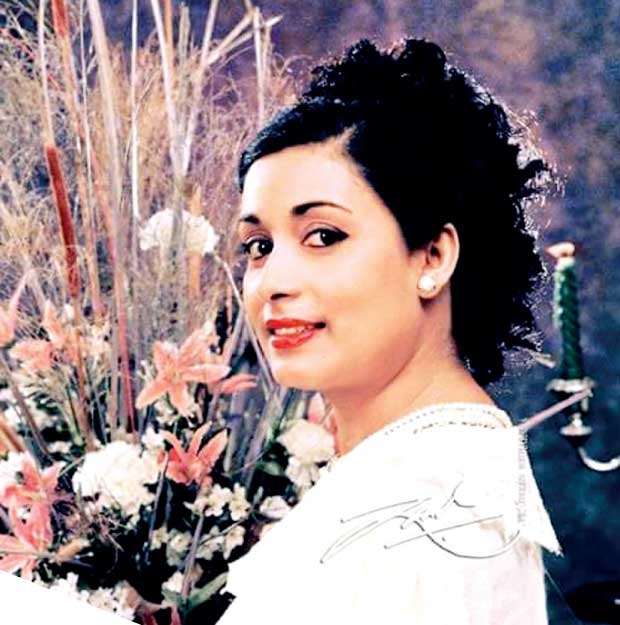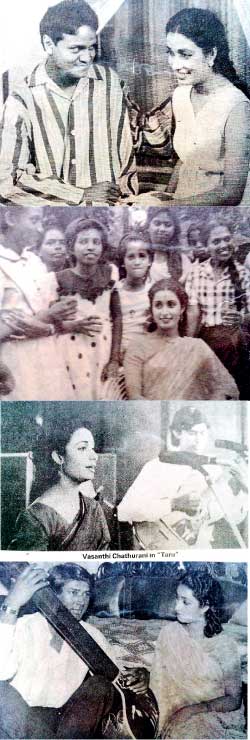Reply To:
Name - Reply Comment

 There’s a sweet, almost naive sense of innocence in the early performances of Vasanthi Chathurani. It’s a new sensibility, to me, since a very few actors here, male or female, have been as able as she has been to project a form of purity that is at once enticing and delicate. Most of our actors are content in entrancing us and forming part of our wildest fantasies.
There’s a sweet, almost naive sense of innocence in the early performances of Vasanthi Chathurani. It’s a new sensibility, to me, since a very few actors here, male or female, have been as able as she has been to project a form of purity that is at once enticing and delicate. Most of our actors are content in entrancing us and forming part of our wildest fantasies.
Vasanthi doesn’t get us to think of her like this. More often than not, she wins our sympathy, our deepest fears and sorrows, because she’s at home with characters, with daughters, sisters, wives, and mothers, whose main role is to puncture their beauty and sense of charm with a welter of delicateness that can break apart at the slightest intrusion. As Kusum in Gehenu Lamayi and as Nirmala in Ganga Addara – the twin peaks of her early career – she epitomises this kind of female figure so well that she transforms herself into a different acting sensibility, the sensibility I referred to above.
It’s pertinent here to place Vasanthi in a particular context, in our cinema, before moving on to her career. Our actresses more or less continue a tradition begun by Rukmani Devi, a tradition that was passed over to Malini Fonseka in the early seventies. I believe it was Asoka Handagama who observed that Fonseka’s characters are definable by their ability to get every man to hanker after her. This is as true for her mainstream ventures as it is for her less commercial essays – Eya Dan Loku Lamayek and Baddegama – and her roles in films that take an intermediate position between the box-office and serious art – including Apeksha and Diyamanthi. She epitomises, not rebellion, but surrender.
Between the Malini Fonseka of the seventies, who symbolised feminine goodness (largely patriarchal, reflecting the attitudes of popular audiences), and the Swarna Mallawarachchi of the eighties, who symbolised rebellion and retribution, we have Vasanthi Chathurani, who falls into neither category and yet somehow is at home with both. Vasanthi’s most discernible quality in this respect is her voice, because it can alternate between rebellion and submission.
 In Lester James Peries’s Awaragira, she articulates respect towards their family manor and, later, her love towards a very abusive husband (Lucky Dias), with that voice, signifying the conflict at the heart of her tragedy. But before Awaragira there were other films, all of which followed her transition from the girl next door to a veritable matriarch, and all of which reflected her penchant for delicate beauty. It’s the kind of beauty that can waste away at the hands of abuse, which incidentally is her eventual destiny: to be made use of, rather cruelly and unfairly.
In Lester James Peries’s Awaragira, she articulates respect towards their family manor and, later, her love towards a very abusive husband (Lucky Dias), with that voice, signifying the conflict at the heart of her tragedy. But before Awaragira there were other films, all of which followed her transition from the girl next door to a veritable matriarch, and all of which reflected her penchant for delicate beauty. It’s the kind of beauty that can waste away at the hands of abuse, which incidentally is her eventual destiny: to be made use of, rather cruelly and unfairly.
At the end of Gehenu Lamayi, Kusum asks of everyone, including us, “Is this my fate?” The director, Sumitra Peries, resorts to a literal transposition of her imaginings with a dissolve into a carved question mark on a mirror. That was a pretty prescient indication of the type of roles she would be asked to churn out for the next 10 years – in Ganga Addara, in Siribo Aiya, in Parithyagaya, in Adara Hasuna – barring the occasional detour that didn’t always seem convincing – particularly in Biththi Hathara, where her depiction of a sensual woman, who seduces the protagonist (Neil Alles) didn’t, to me at least, seem congruent with her earlier character portrayals – but sometimes was, as with Para Dige, Siribo Aiya, and Kulageya.
She wins us unconditionally at this point in her career when she’s denied proper agency, where forced against her free will to submit to everyone else before herself: the parents and the rich aunt in Gehenu Lamayi, the irate father in Ganga Addara, the tempestuous, almost insanely jealous husband in Adara Hasuna.
Vasanthi’s story has been recorded and put down in print so much that I will not go beyond a brief recapitulation of her biography. Born Doreen Peterson in Gampaha, she was educated at Holy Cross College, where she excelled in acting and the arts in general despite the opposition such institutions (it was a Convent) displayed towards girls who get ideas of becoming performers and actresses. She was discovered by Sumitra Peries, in the late seventies, but in those first few days of shooting for Gehenu Lamayi she disappointed if not shocked everyone by her refusal to act in front of the camera. Gehenu Lamayi would have come crumbling down were it not for Lester James Peries’s idea to shoot another sequence, with her clad in school uniforms, at St John Bosco’s College in Hatton, where production mercifully proceeded. Gehenu Lamayi was a success, as was Lester’s Ahasin Polawata, but it was Ganga Addara that propelled her to stardom.
She had to be young when playing these characters, obviously, because the submissive women she got to portray couldn’t have been portrayed with sincerity were she an elder, a matriarch. She attempted to return to her youth at the turn of the millennium with two movies that showed just how much of a hurdle age was when embodying fragility and sensitivity: H. D. Premaratne’s Kinihiriya Mal, where she was a convincing but altogether incongruously cast elder sister to Sangeetha Weeraratne; and Chandran Rutnam’s Poronduwa, a film that was aptly summed up with respect to its choice of cast members (including Vasanthi along with her love interest, Ravindra Randeniya) by Nanda Pethiyagoda as follows: “If I were asked to give a prize, a sort of Oscar, for this latest Sinhala film that is being screened at the Regal and other cinemas, I would award it to the makeup man.” Pethiyagoda would write of Vasanthi’s portrayal, “She is no spring chicken,” acknowledging that she had captured something of her earlier avatar.
You come across a faint trace of this new woman even in the eighties, and particularly in Giraya. As Kamini, Vasanthi doesn’t “inhabit” and “occupy” the plot in the way that her counterpart in Punyakanthe Wijenaike’s story (conceived as a series of diary entries, an epistolary novel) does, but her intrusion into that plot rakes up trouble from her mother-in-law (Grace Ariyawimal) and the ominous maid, Lucy Hami (Trilicia Gunawardena). Giraya’s success owes considerably to the larger texture, the wider scope, which its director, Lester Peries, and scriptwriter, Somaweera Senanayake, brought in and affirmed to take it beyond Kamini’s perspective. What happens in the end is that Kamini, far from being the fearful woman the novel depicts her as, triumphs over her fears through her interaction with the other characters: her sister-in-law (Chandani Seneviratne), the gamekeeper (Cyril Dharmawardena), and the village monk (G. R. Perera). Earlier she would have succumbed, yielded; now she persists, like the unnamed protagonist of Du Maurier’s Rebecca, and towers over both the mother-in-law and the maid.
More often than not, she wins our sympathy, our deepest fears and sorrows, because she’s at home with characters, with daughters, sisters, wives, and mothers, whose main role is to puncture their beauty and sense of charm
She tries to echo if not channel this kind of rebellious woman in Awaragira, but fails badly, because that is the fate set for her in the plot. Conceived as a vast family epic, Awaragira is rather episodic in its structure: ranging from the stubborn misadventures of the elder son (Kamal Addaraarachchi) to the thwarted idealism and romances of the younger son (Ranjan Ramanayake), its characters shift from one mood to another, from the hopefulness to deterioration and then complete annihilation.
Set against such a large backdrop even Vasanthi changes wildly: in the very first scene she’s in, she proclaims her fidelity to the family and her father, but as the plot progresses she finds herself confusingly lost between her love for her family and for her abusive husband.
There’s a sequence in Awaragira which shows this growing, irreconcilable rift between Vasanthi the girl and Vasanthi the woman. It opens up in the second half of the story, when the family has begun to deteriorate. Awaiting her husband, we see her on a sofa; there are dark spots under her eyes. The wind ruffles her hair, the camera closes in on her, and she gets up after hearing the sound of a car outside. Lucky Dias, cheerful as always, comes up the stairs.
“You’re always complaining about me coming home late, so I came early today,” he tells her, handing over a cake to her. Without a word, she takes it and prepares to make some tea for him. The husband is bewildered: “Vasa? What is the problem?” he asks. She replies with an irresolute shaking of the head. Unconvinced, he tries to allay her fears by caressing her, smiling. She nods, barely. In the next sequence featuring these two, they are no longer smiling and nodding; they are fighting.
By this time the family fortunes have begun to sink, and in this sequence, brief and superficially unimportant though it is, Vasanthi becomes a new woman, moving away from the idealism of her youth. That she fails to make this shift owing to her naiveté proves to be her undoing and her brother’s.
In the end she channels the woman beneath her, asserts herself, and kills that brother in a sequence that was so choppily and arbitrarily edited by its producer that it fails to do justice to her; but even with this limitation, the murder reminds me, as I mentioned elsewhere, of the killing of Zhivony in Wajda’s Siberian Lady Macbeth, also about a female figure torn between two men.
By this point in her career she had been repressed so much that she aged beyond her years. Her subsequent career, as a result, would never be the same again: Awaragira coincided with the era in which she began producing tele-dramas, almost all of which (starting with Iti Pahana) had her as a stubborn but well-meaning mother. It’s a different Vasanthi we come across here: no longer the girl next door, she has by now embraced the matriarchal figure she was destined to embrace.
It’s that matriarchal figure she has now completely been taken over: as a mother, as a sister, as a wife, and of course as a teacher. No longer with that welter of innocence which shrouded her before, she has become the kind of understanding, but determined and assertive person she continues to be today.